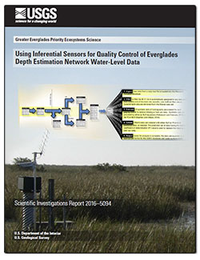Using inferential sensors for quality control of Everglades Depth Estimation Network water-level data
Links
- Document: Report (14.9 MB pdf)
- Related Work: Open-File Report 2016–1116 - User’s Manual for the Automated Data Assurance and Management Application Developed for Quality Control of Everglades Depth Estimation Network Water-Level Data
- Download citation as: RIS | Dublin Core
Abstract
The Everglades Depth Estimation Network (EDEN), with over 240 real-time gaging stations, provides hydrologic data for freshwater and tidal areas of the Everglades. These data are used to generate daily water-level and water-depth maps of the Everglades that are used to assess biotic responses to hydrologic change resulting from the U.S. Army Corps of Engineers Comprehensive Everglades Restoration Plan. The generation of EDEN daily water-level and water-depth maps is dependent on high quality real-time data from water-level stations. Real-time data are automatically checked for outliers by assigning minimum and maximum thresholds for each station. Small errors in the real-time data, such as gradual drift of malfunctioning pressure transducers, are more difficult to immediately identify with visual inspection of time-series plots and may only be identified during on-site inspections of the stations. Correcting these small errors in the data often is time consuming and water-level data may not be finalized for several months. To provide daily water-level and water-depth maps on a near real-time basis, EDEN needed an automated process to identify errors in water-level data and to provide estimates for missing or erroneous water-level data.
The Automated Data Assurance and Management (ADAM) software uses inferential sensor technology often used in industrial applications. Rather than installing a redundant sensor to measure a process, such as an additional water-level station, inferential sensors, or virtual sensors, were developed for each station that make accurate estimates of the process measured by the hard sensor (water-level gaging station). The inferential sensors in the ADAM software are empirical models that use inputs from one or more proximal stations. The advantage of ADAM is that it provides a redundant signal to the sensor in the field without the environmental threats associated with field conditions at stations (flood or hurricane, for example). In the event that a station does malfunction, ADAM provides an accurate estimate for the period of missing data. The ADAM software also is used in the quality assurance and quality control of the data. The virtual signals are compared to the real-time data, and if the difference between the two signals exceeds a certain tolerance, corrective action to the data and (or) the gaging station can be taken. The ADAM software is automated so that, each morning, the real-time EDEN data are compared to the inferential sensor signals and digital reports highlighting potential erroneous real-time data are generated for appropriate support personnel. The development and application of inferential sensors is easily transferable to other real-time hydrologic monitoring networks.
Suggested Citation
Petkewich, M.D., Daamen, R.C., Roehl, E.A., and Conrads, P.A., 2016, Using inferential sensors for quality control of Everglades Depth Estimation Network water-level data: U.S. Geological Survey Scientific Investigations Report 2016–5094, 25 p., https://dx.doi.org/10.3133/sir20165094.
ISSN: 2328-0328 (online)
Study Area
Table of Contents
- Abstract
- Introduction
- Data Collection Network
- Automated Data Assurance and Management (ADAM) Software
- ADAM Software Architecture
- Using ADAM Software to Process Everglades Depth Estimation Network Data
- Summary
- References Cited
| Publication type | Report |
|---|---|
| Publication Subtype | USGS Numbered Series |
| Title | Using inferential sensors for quality control of Everglades Depth Estimation Network water-level data |
| Series title | Scientific Investigations Report |
| Series number | 2016-5094 |
| DOI | 10.3133/sir20165094 |
| Publication Date | September 29, 2016 |
| Year Published | 2016 |
| Language | English |
| Publisher | U.S. Geological Survey |
| Publisher location | Reston, VA |
| Contributing office(s) | South Atlantic Water Science Center |
| Description | v, 25 p. |
| Country | United States |
| State | Florida |
| Other Geospatial | Everglades |
| Online Only (Y/N) | Y |


